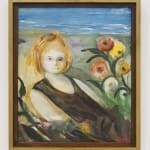



Patricia France
The Flower Girl, 1991
oil on board
580 x 485mm
650 x 565 x 35mm framed
650 x 565 x 35mm framed
On Loan, Private Collection
Further images
Patricia France 1911 – 1995 After taking up painting aged in her 50s, Patricia France created a unique body of figurative painting. France grew up in various locations in the...
Patricia France
1911 – 1995
After taking up painting aged in her 50s, Patricia France created a unique body of figurative painting. France grew up in various locations in the North Island and had thought to pursue medicine at university. But restrictive ideas about the role of women in society at that time saw her family persuade her otherwise. According to journalist Christopher Moore, France studied for two years at a Paris branch the New York School of Interior Design in the early 1930s. There she created “precise, controlled architectural drawings”, and it wasn’t until many years later that she started to paint her distinctive works of gestural portraiture.
France was troubled by depressive illness, and this led to several stints in a psychiatric hospital in Dunedin in the 1950s. Like the author Janet Frame, France narrowly avoided a frontal leucotomy as part of her treatment. She found solace in painting, along with a sense of purpose. In a 1987 review of France’s work in Wellington’s Evening Post newspaper, writer Ian Wedde stated, “Looking from this painting to the more familiar ones in the show, you realise how capable Pat France is - how much change she is able to convey through what are really minor adjustments to her language and repertoire. Like Evelyn Page, Patricia France is a painter whose achievement looks ripe for reappraisal. The work has persisted in ways which have more to them than charm.” France’s 1991 work The Flower Girl demonstrates the unique charm and skill she brought to painting.
1911 – 1995
After taking up painting aged in her 50s, Patricia France created a unique body of figurative painting. France grew up in various locations in the North Island and had thought to pursue medicine at university. But restrictive ideas about the role of women in society at that time saw her family persuade her otherwise. According to journalist Christopher Moore, France studied for two years at a Paris branch the New York School of Interior Design in the early 1930s. There she created “precise, controlled architectural drawings”, and it wasn’t until many years later that she started to paint her distinctive works of gestural portraiture.
France was troubled by depressive illness, and this led to several stints in a psychiatric hospital in Dunedin in the 1950s. Like the author Janet Frame, France narrowly avoided a frontal leucotomy as part of her treatment. She found solace in painting, along with a sense of purpose. In a 1987 review of France’s work in Wellington’s Evening Post newspaper, writer Ian Wedde stated, “Looking from this painting to the more familiar ones in the show, you realise how capable Pat France is - how much change she is able to convey through what are really minor adjustments to her language and repertoire. Like Evelyn Page, Patricia France is a painter whose achievement looks ripe for reappraisal. The work has persisted in ways which have more to them than charm.” France’s 1991 work The Flower Girl demonstrates the unique charm and skill she brought to painting.



